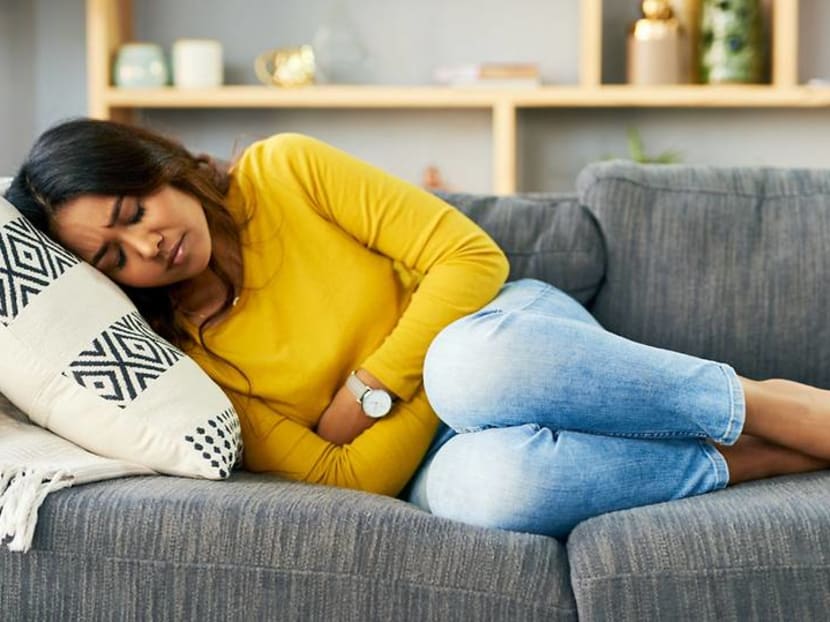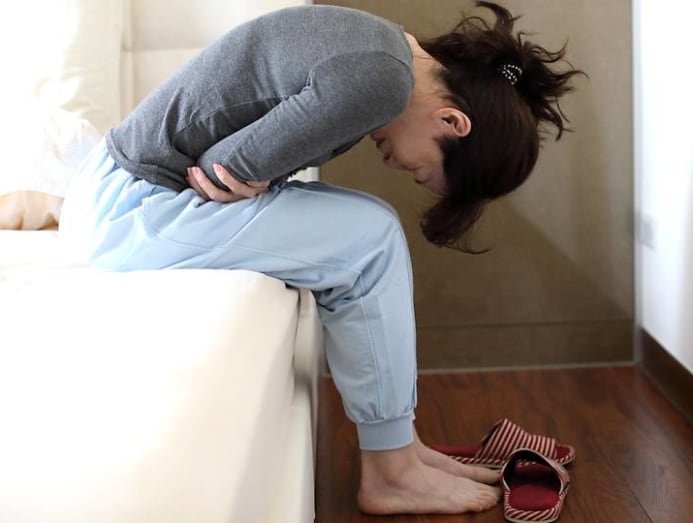Why menstrual cramps hurt a lot – and what painkillers and natural remedies to try
Even when it comes to pain relievers, some are more effective than others. CNA Lifestyle breaks down the whole list, from paracetamol to chamomile tea.

(Photo: iStock/Moyo Studio)
If you suffer from bad menstrual cramps or know someone who does, you’d know that it’s not just in the mind – and saying things like “just deal with it” and “other women also have it” just doesn’t help.
Many women do indeed experience painful menstrual cramps or primary dysmenorrhoea that is not caused by gynaecological disease.
This is different from the period pain caused by reproductive disorders such as endometriosis, fibroids and pelvic inflammatory disease, which is known as secondary dysmenorrhoea. The cramps caused by intrauterine contraceptive devices, especially copper ones, are also classified as secondary dysmenorrhoea.
READ: Is heavy menstrual bleeding normal? And what does eating pineapple have to do with it?
In fact, dysmenorrhea is one of the common gynaecological problems among women, according to Dr Susan Logan, a senior consultant at National University Hospital’s Division of Reproductive Endocrinology & Infertility, under the Department of Obstetrics & Gynaecology.
“The prevalence of dysmenorrhoea can vary between 16 per cent and 91 per cent in women of reproductive age.”
Yet, despite the monthly pain, only about 6 per cent consulted a doctor for their problem, according to a 1992 community-based questionnaire survey on 415 women aged 15 to 54 in Clementi, cited Dr Logan, who is also the co-lead for women’s health at Alexandra Hospital.

WHY DOES IT HURT SO MUCH?
“Pain tolerance is different in every woman but dysmenorrhoea is not an uncommon referral to emergency departments,” said Dr Logan.
Women with primary dysmenorrhoea tend to have raised levels of prostaglandins (fat compounds that have hormone-like effects), which cause more intense contractions of the uterus than normal.
According to Dr Logan, prostaglandins are secreted by the uterine lining at the beginning of menstruation, usually in the first one or two days. These prostaglandins are what cause the uterus to contract and dislodge the lining, which women experience as the monthly menstrual flow. “The intensity of the pain is proportionate to the amount of prostaglandins released,” she said.
Dysmenorrhoea is not an uncommon referral to emergency departments.
Other hormones that can cause painful periods include progesterone and vasopressin, said Dr Logan. For progesterone, it is a drop in its level that leads to the cramps. Meanwhile, vasopressin also causes uterine contractions like prostaglandins.
“Menstrual cycles, where ovulation does not take place, are usually less painful or painless,” said Dr Logan. That’s right, women do not always ovulate every month and this phenomenon can be caused by extreme stress or medical issues such as hypothyroidism.
However, despite knowing the hormones that come into play, “the pathophysiology of primary dysmenorrhoea is not completely understood”, said Dr Logan.

WHICH PAIN RELIEF METHODS REALLY HELP?
Until companies and human resource departments implement menstrual leave or make work-from-home arrangements an option, women continue to pad up and soldier on when it comes to the time of the month.
But there are pain relief methods that purportedly help to alleviate the monthly discomfort. CNA Lifestyle poses these methods to the experts to find out how they work.
- PARACETAMOL
If you’re not opposed to taking painkillers, they are actually the “simple, natural choice for dysmenorrhoea”, said Dr Tan Toh Lick, an obstetrician and gynaecologist with Thomson Women’s Clinic (Jurong) and Thomson Surgical Centre.
Paracetamol is the most common painkiller here. “It is useful for women who are unable to take nonsteroidal anti-inflammatory drugs,” said Dr Tan. (More about NSAIDs in a bit.)
“It also does not typically have bad gastrointestinal side effects” and “can be taken with or without food”, he added.
READ: What causes water retention and how to deal with swollen ankles and fingers
What about Panadol Menstrual versus regular Panadol? The menstrual version has pain-relieving paracetamol as well as pamabrom, which is a mild diuretic to help relieve water retention and bloating. So, if cramps are the main problem (and not bloating), regular Panadol will do the trick.
But paracetamol’s availability may sometimes cause people to be complacent. For instance, it should not be taken if you have acute or severe liver disease, cautioned Dr Tan. “It can also affect other medication, including anti-convulsants.”

- MEFENAMIC ACID
Although less commonly used in Singapore, NSAIDs such as the prescription-only mefenamic acid are also available.
In fact, mefenamic acid can be more effective than paracetamol as it can “block prostaglandin action”, said Dr Tan. Like other NSAIDs, mefenamic acid can also “inhibit prostaglandin synthesis”.
Mefenamic acid has its downsides though. It has to be taken with food, and it should not be used if you have gastric bleeding or ulcer; inflammatory bowel disease; renal, liver or heart disease; a history of asthma; or an allergy to NSAIDs such as aspirin, cautioned Dr Tan.
Furthermore, mefenamic acid can interact with medications such as those for blood pressure. It may also have a “negative effect” on ovulation, he advised, which may make it unsuitable for women trying to conceive.
- VITAMIN D
Google “period pain” and you’ll see advertisements that advocate certain vitamins and minerals for dysmenorrhoea. But do they work? “There is a paucity of evidence with most data limited to a few small studies,” said Dr Tan.
But if you’re still keen to give vitamins a go, 50,000 IU of Vitamin D a week for eight weeks “appear to reduce dysmenorrhoea in women with Vitamin D deficiency” in studies, he said.
Dietitian Caleb Mok with PanAsia Surgery highlighted that “Vitamin D deficiency is widespread nowadays” and it is “recommended to check your blood Vitamin D levels and replenish accordingly”.
Still, taking 50,000 IU of Vitamin D a week, or more than 7,100 IU a day (you need only 400 IU to 800 IU daily) is astronomically high, said Dr Tan. If you wish to supplement with Vitamin D, it is prudent to see a doctor or dietitian about the dosage you need.

- CALCIUM
The nutrient most commonly associated with milk and cheese can purportedly reduce cramps by 58 per cent. Some studies even associate more muscle spasms and contractions in the uterus with low calcium levels, said Jaclyn Reutens, a dietitian and the founder of Aptima Nutrition & Sports Consultants.
As for the dosage and frequency, they vary, she said. For instance, one study suggested 500mg to 1,000mg a day, while another recommended 1,000mg of calcium on the 15th day of the menstrual cycle to reduce the impending menstrual cramps.
There is a low risk of over-dosing as the daily recommended allowance for calcium, according to the Healthhub website, is about 800mg to 1,000mg. If you’re concerned about the dosage, check with your doctor first before starting supplementation.
“Avoid taking calcium with iron and zinc supplements, thyroid medications and certain antibiotics,” cautioned Reutens.

- MAGNESIUM
Magnesium acts like a muscle relaxant, according to Reutens. “It helps to soothe and tone the uterine muscles, and reduces the prostaglandins that cause pain,” she said.
It also appears to work well when taken together with Vitamin B6, which is associated with the nervous system, Reutens noted. “In a clinical study of 150 women, the combination of magnesium (250mg) and Vitamin B6 (40mg) had the best pain relief as compared to the placebo group or the group taking only magnesium (250mg).”
Reutens recommended a daily dose of 250mg to 350mg of magnesium but no more than 350mg a day to avoid over-dosing.
READ: Not sure if you can exercise during your period? Here's what the experts say
However, magnesium isn’t suitable for individuals with severe kidney impairment. Also, avoid taking magnesium with antibiotics as the supplement can decrease certain antibiotics’ effectiveness or reduce the amount of antibiotics your body absorbs.
Your best bet: Take the antibiotics at least two hours before, or four to six hours after magnesium supplements.
- OMEGA FATTY ACIDS
“In our typical diet, the arachidonic acid from animal-derived foods collects in the uterus and this can lead to inflammation,” said Reutens. “Omega-3 fatty acids are known for their anti-inflammatory properties that can help to relieve pain.”
READ: Sharper brain, higher pain threshold – here's how to take advantage of your cycle
Omega-3 fatty acids may also contribute to “healthy clotting mechanisms” by suppressing the production of prostaglandins, she said, adding that the pills also provide heart-healthy benefits.
Reutens suggested taking 1,000mg daily to help with menstrual cramps but avoid taking omega fatty acids with anti-coagulants, anti-platelet medicine, or any blood-thinning medicines or supplements.

- FENNEL SEED EXTRACT
There are some common natural remedies that may help to relieve primary dysmenorrhea, said Mok. They usually do so by “promoting muscle relaxation, balancing the natural chemicals in the body that cause uterine contractions, and reducing inflammation that causes pain”, he said.
Still, he said that it is “strongly advisable” to consult your doctor first, especially if you have other health issues or are taking medications, before taking any herbs.

Fennel seeds and their extract have been used by parents to soothe the muscle spasms in colicky infants, said Mok, and the herb’s muscle-calming ability may also apply to painful menstrual cramps. “The benefit may be related to the inhibition of pain-inducing cytokines in the body,” said Mok.
“In one study, consuming capsules containing 30mg of fennel extract four times a day for three days prior to the start of the menstruation has shown significant reduction in menstrual pain among the study group,” he said.
- EVENING PRIMROSE OIL
The oil is rich in anti-inflammatory fatty acids, such as gamma-linolenic acid, which may modulate the inflammatory signals in the body that are associated with pain.
“Studies have found evening primrose oil or GLA to be effective in reducing menstrual cramps and premenstrual syndrome,” said Mok.
According to Healthline, the recommended dose is eight to 12 capsules a day, at 500mg per capsule.

- GINGER POWDER OR TEA
No stranger in Asian cuisines, ginger has also been used by proponents of natural remedies to help alleviate cramps, said Mok.
He added: “Ginger is rich in anti-inflammatory and antioxidative phytochemicals that can combat inflammation, and balance the chemicals in the body which cause pain”.
READ: Period-proof underwear is a thing – and can help ladies during awkward moments
In fact, a review of seven studies, including over 600 women, found that consuming 750mg to 2,000mg of ginger powder during the first three to four days of their period appeared to help reduce period pain.
A study on 168 female college students noted that taking 200mg of ginger (in capsules) every six hours was as effective as Novafen, which is a combination of ibuprofen, acetaminophen and caffeine, at reducing menstrual pain.

If you’re not keen to buy ginger capsules from the pharmacy (although the studies showing ginger’s efficacy is based on capsules), you could make a ginger tea by grating the root into hot water, suggested Mok.
- CHAMOMILE TEA
According to Mok, chamomile tea may increase glycine, which is a nerve and muscle relaxant, in the body.
“In addition, the phytochemicals in chamomile may also reduce the production of prostaglandins in the uterus,” he said.
Mok suggested drinking two cups of chamomile tea a day for a week before the start of every period.





